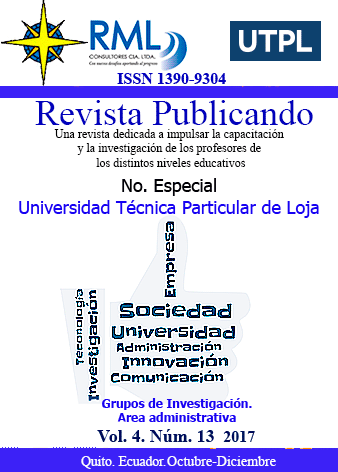Resumen
El presente trabajo de investigación tiene por objeto elaborar un modelo que verifique que el rendimiento empresarial es influenciado por la holgura financiera de las empresas grandes del Ecuador. Para cumplir con el objetivo se ha extraído una muestra de las 100 empresas más grandes del país del 2012 al 2016, de acuerdo a los estados financieros obtenidos de la Superintendencia de Compañías del Ecuador. La metodología empleada es un modelo econométrico de datos panel con efectos aleatorios y efectos fijos. Las variables dependientes son el rendimiento económico y rentabilidad financiera. Las variables independientes son: la holgura financiera, holgura de capital, holgura de efectivo, liquidez y tamaño de la empresa. Los resultados obtenidos presentan una evidencia empírica que menciona que el rendimiento económico y financiero de las empresas grandes del Ecuador depende significativamente de la holgura generada.
Referencias
Argilés, J.M.; Garcia Blandón, J.; Martínez Blasco, M. (2015), “The relationship between slack and firm performance revisited”, Special conference on Corporate Strategy and Resource Redeployment.
Baker, T. and R.E. Nelson, 2005, “Creating something from nothing: resource construction through entrepreneurial bricolage”. Administrative Science Quarterly, 50: 329-366.
Bourgeois, L. J., & Singh, J. 1983. “Organizational slack” 674 Academy of Management Journal August and political behavior within top management groups. Academy of Management Proceedings: 43–49.
Bourgeois, L., 1981, “On the measurement of organizational slack”. Academy of Management Review, 6: 29-39.
Cyert, R., and J. March, 1956, “Organizational factors in the theory of oligopoly”. Quarterly Journals of Economics, 70, 44-64.
Daniel, F., Lohrke, F. T., Fornaciari, C. J., & Turner, R. A. (2004). “Slack resources and firm performance: a meta-analysis”. Journal of Business Research, 57(6), 565– 574.
Delmar, F., Hunter, L., King, A., Schwab, D., Terlaak, A., & Trevor, C. (2005). “Slack Resources and the Performance of Privately Held Firms”. Journal Academy of Management, 48(4), 661-676.
Galbraith, J., 1973 “Designing complez organizations. Raeding. MA: Addison – Wesley.
George, G., 2005, “Slack resources and the performance of privately held firms”. Academy of Management Journal, 48, 661-676.
Greenixy, G., & Oktemgil, M., 1998. “A comparision of Slack resources in high and low performing british gompanies”. Journal of Management Studies, (May), 393.
Huang, J.W., and Y.H. Li, 2012, “Slack resources in team learning and project performance”. Journal of Business Research, 65, 381-388.
Modi, S.B., and S. Mishra, 2011, “What drives financial performance-resource efficiency or resource slack? Evidence from U.S. based manufacturing firms from 1991 to 2006”. Journal of Operations Management, 29, 254-273.
Peng, M.W., Y. Li, E. Xie and Z. Su, 2010, “CEO duality, organizational slack, and firm performance in China”. Asia Pacific Journal of Management, 27, 611-624.
Sharfman, M., G. Wolf, R. Chase and D. Tansik, 1988, “Antecedents of organizational slack”. Academy of Management Review, 13, 691-614
Su, Z., E. Xie, D. Wang and Y. Li, 2011, “Entrepreneurial strategy making, resources, and firm performance: evidence from China”. Small Business Economics, 36, 235- 247.
Tan, J. and M.W. Peng, 2003, “Organizational slack and firm performance during economic transitions: two studies from an emerging economy”. Strategic Management Journal, 24, 1249-1263.
Tan, J., and L. Wang, 2010, “Flexibility-efficiency tradeoff and performance implications among Chinese SOEs”. Journal of Business Research, 63, 356-362.
Thompson, J.D., 1967, “Organizations in Action”. New York: McGraw-Hill.
SUPERCIAS, (2017). Disponible en: http://www.supercias.gob.ec/portalscvs/ [Accessed 15 Oct. 2017].
Xu, E., Yang, H., Quan, J. M., & Lu, Y. (2014). “Organizational slack and corporate social performance: Empirical evidence from China”™s public firms”. Asia Pacific Journal of Management, 32(1), 181–198.
Yang, C., and H.M. Liu, 2012, “Boosting firm performance via enterprise agility and network structure”. Management Decision, 50, 1022-1044.
Usted es libre de:
Compartir — copiar y redistribuir el material en cualquier medio o formato
Adaptar — remezclar, transformar y construir a partir del material
La licenciante no puede revocar estas libertades en tanto usted siga los términos de la licencia
Bajo los siguientes términos:
Atribución — Usted debe dar crédito de manera adecuada, brindar un enlace a la licencia, e indicar si se han realizado cambios. Puede hacerlo en cualquier forma razonable, pero no de forma tal que sugiera que usted o su uso tienen el apoyo de la licenciante.
NoComercial — Usted no puede hacer uso del material con propósitos comerciales.
CompartirIgual — Si remezcla, transforma o crea a partir del material, debe distribuir su contribución bajo la lamisma licencia del original.
